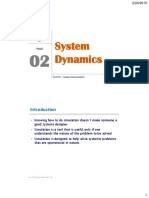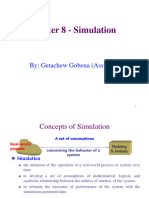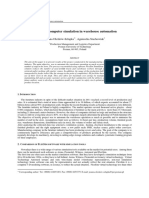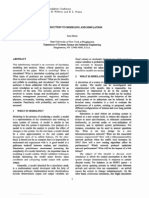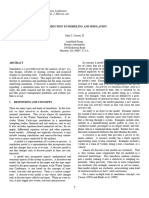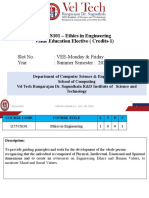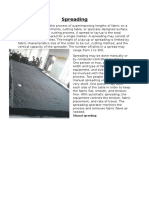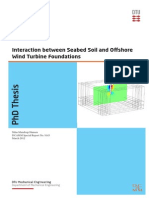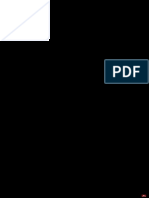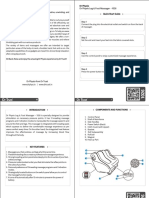3/12/2015
Week
05
Model
Development
TI141317 Simulasi Sistem Industri
Contents
How do you prepare to do a simulation study?
What are the steps for doing a simulation study?
What are typical objectives for a simulation study?
What is required to successfully complete a
simulation project?
What are some pitfalls to avoid when doing
simulation?
Lab. KOI
Jurusan Teknik Industri - ITS
�3/12/2015
Contents
See Chapter One Why When What Simulation
Selecting an Application
Pre-eliminary activities
Software Selection
Personal Identification
Defining the Objective
Defining the Scope Of Work
- Model Scope
- Level Of Detail
- Data Gathering Responsibilities
- Planning Experimentation
- Form of results
Simulation Procedure
Defining Project Requirements
Pitfalls Why simulation projects fail
6
Lab. KOI
Jurusan Teknik Industri - ITS
Preliminary Activities
The decision to use simulation itself requires
some consideration. Is the application
appropriate for simulation? Are other
approaches equally as effective yet less
expensive? Hence we should know WWW
of simulation, what, why, when.
(see chapter one presentation)
Lab. KOI
Jurusan Teknik Industri - ITS
�3/12/2015
Preliminary Activities
1. Selecting an Application
Is the process well defined?
Is process information readily available?
Does the process have interdependencies?
Does the process exhibit variability?
Are the potential cost savings greater than the cost of
doing the study?
If it is a new process, is there time to perform a simulation
analysis?
If it is an existing process, would it be less costly to
experiment on the actual system?
Is management willing to support the project?
Lab. KOI
Jurusan Teknik Industri - ITS
Preliminary Activities
2. Personal identification
Lab. KOI
Management assign a project leader who works alone
or with a project team
It may be more cost effective to hire a simulation
consultant than to do the simulation in-house
A simulation specialist should be assigned to lead and
an engineer (manager) who works closely with the
specialist should be assigned
Personnel must be identified and trained
The process owner should take an active role in the
project
Jurusan Teknik Industri - ITS
�3/12/2015
Preliminary Activities
3. Software selection
Lab. KOI
Simulation software cant make a simulation succeed, but
it can make it fail
Selecting the right simulation software requires that an
assessment first be made to the simulation requirements.
Alternative products should be evaluated against those
requirements
Selection criteria: quality, features and capability, ease
of use, services, and cost
Jurusan Teknik Industri - ITS
Simulation Software
Lab. KOI
Software
Arena
AutoMod
Awe Sim
Enterprise Dynamics
Extend
Flexsim
GPSS/H
Micro Saint
ProModel (MedModel, ServiceModel)
Quest
ShowFlow
SIGMA
Supplier
Rockwell Software
Brooks-PRI Automation
Frontstep, Inc.
Incontrol Enterprise Dynamics
Imagine That, Inc
Flexsim Software Products, Inc.
Wolverine Software Corporation
Micro Analysis and Design
ProModel Corporation
DELMIA Corporation
Webb Systems Limited
Custom Simulation
Simprocess
CACI Products Company
Simul8
Visual8 Corporation
SLX
Wolverine Software Corporation
Visual Simulation Environment
Orca Computer, Inc.
Witness
Lanner Group, Inc.
Jurusan Teknik Industri - ITS
�3/12/2015
Simulation Software
Feature
Spreadsheet
Programming
language
Specialist simulation
software
Range of application
Low
High
Medium
Modeling flexibility
Low
High
Medium
Duration of model build
Medium
Long
Short
Ease of use
Medium
Low
High
Ease of model validation
Medium
Low
High
Run-speed
Low
High
Medium
Time to obtain software skills
Short (medium for
macro use)
Long
Medium
Price
Low
Low
High
Lab. KOI
Jurusan Teknik Industri - ITS
Simulation Procedure
Step 1 : Define objective, scope, and requirements
Step 2 : Collect and analyze system data
Step 3 : Build the model
Step 4 : Validate the model
Step 5 : Conduct experiments
Step 6 : Present the result
(Each step need not be completed in its entirely before moving to
the next step)
Lab. KOI
Jurusan Teknik Industri - ITS
�3/12/2015
Simulation Procedure
Define objective, scope, and requirements
Collect and analyze system data
Build model
Validate model
Conduct experiment
Present result
Lab. KOI
Jurusan Teknik Industri - ITS
Defining The Objective
The objective of a simulation defines the purpose
or reason for conducting the simulation study.
It should be realistic and achievable, given the
time and resource constraints of the study
Lab. KOI
Jurusan Teknik Industri - ITS
�3/12/2015
Defining The Objective
Simulation objectives can be grouped into the
following general categories :
Performance analysis
What is the all-around performance of
the system in terms of resource utilization, flow time, output
rate, and so on?
When pushed to the maximum, what
is the processing or production capacity of the system and
where are the bottlenecks?
Capacity/constraint analysis
Configuration comparison
How well does one system
configuration meet performance objectives compared to
another?
Lab. KOI
Jurusan Teknik Industri - ITS
Defining The Objective
Optimization What setting for particular decision
variables best achieve desired performance goals ?
Sensitivity analysis - Which decision variables are
the most influential on performance measures, and
how influential are they?
Visualization How can system dynamics be most
effectively visualized?
Lab. KOI
Jurusan Teknik Industri - ITS
�3/12/2015
Defining The Objective
Examples of Specifics Objectives
Lab. KOI
Design Decisions
What are the optimum number and size of waiting areas, storage
areas, queues, and buffers?
What is the optimum unit load or batch size for processing?
Where are the bottlenecks in the system, and how can they be
eliminated?
Operational Decisions
What is the best schedule for preventive maintenance?
What is the best priority rule for selecting the jobs and tasks?
How many personnel should be scheduled for a particular shift?
Jurusan Teknik Industri - ITS
Test Yourself
For each of the following systems, define one possible objective:
Lab. KOI
A manufacturing cell
A fast-food restaurant
An emergency room of a hospital
A tire distribution center
A public bus transportation system
A post office
A rental car agency at a major airport
Jurusan Teknik Industri - ITS
�3/12/2015
Defining The Objective
It is always best if objectives can be clearly,
completely, and precisely stated.
To be effective, an objective should be one that
Has high potential impact
Is achievable
Is specific
Is quantifiable
Is measurable
Identifies any relevant constraints
Lab. KOI
Jurusan Teknik Industri - ITS
Defining the Scope of Work
The scope of work is important for guiding the study
as well as providing a specification of the work to be
done upon which all can agree
An important part of the scope is a specification of
the models that will be built. When evaluating
improvements to an existing system, it is often
desirable to model the current system first. This is
called an as-is model.
As-is model results are statistically compared with
outputs of the real-world system to validate the
simulation model
Lab. KOI
Jurusan Teknik Industri - ITS
�3/12/2015
Defining the Scope of Work
As-is model can be used as a benchmark or baseline
to compare the result of to-be models.
To ensure that the budget and schedule are realistic,
a detailed specification should be drafted to include:
Model scope
Level of detail
Data-gathering responsibilities
Experimentation
Form of results
Lab. KOI
Jurusan Teknik Industri - ITS
Defining the Scope of Work
Determining Model Scope
Model scope refers to what system elements should be
represent in the model
Determining the scope of a model should be based on
how much impact a particular activity has on achieving the
objectives of the simulation
Decision regarding model scope relates to the model
boundaries
A common tendency for beginners is to model the entire
system, even when the problem area and all relevant
variables are actually isolated within a smaller subsystem
Lab. KOI
Jurusan Teknik Industri - ITS
10
�3/12/2015
Defining the Scope of Work
In addition to limiting the model boundaries, other
system elements may be excluded from a model due to
their relevance.
The determination of what elements can be eliminated
should be based on their relevance to the objectives of
the study
Activity
A
Activity B
Activity C
Activity
D
Activity E
Scope of model
Lab. KOI
Jurusan Teknik Industri - ITS
Defining the Scope of Work
Deciding on Level of Detail
The level of detail determines the depth of a model.
Real world system can be modeled as a single black
box or white box model
Too much detail makes it difficult and time-consuming to
develop and debug the model. Too little detail may make
the model unrealistic by oversimplifying the process.
Level of detail is determined largely by the degree of
accuracy required in the result
Lab. KOI
Jurusan Teknik Industri - ITS
11
�3/12/2015
Defining the Scope of Work
One-to-one
correspondence
Level of detail
Minimum
required
Model development time
Lab. KOI
Jurusan Teknik Industri - ITS
Defining the Scope of Work
Assigning DataGathering Responsibilities
In any simulation project, data gathering is almost always
the most difficult and time-consuming task.
Identifying data requirements and who will be responsible
for gathering the data is essential if this activity is to
succeed
If the modeler is responsible for gathering data, it is
important to have the full cooperation of those who
possess the data, including equipment vendors, engineers,
technicians, direct labor personnel, and supervisors.
Lab. KOI
Jurusan Teknik Industri - ITS
12
�3/12/2015
Defining the Scope of Work
Planning the Experimentation
The basic premise is that you are not ready to improve a
system until you understand how the current system
operates.
Once a model of the current system is built, it is easier to
visualize what changes need to be made for the modified
system. Both system may even be modeled together in the
same simulation and made to run side by side
The number and nature of the scenarios or alternative
configurations is influenced by the time constraints of the
study
Lab. KOI
Jurusan Teknik Industri - ITS
Defining the Scope of Work
Determining the Form of Result
The form of results to be presented can significantly affect
the time and effort involved in the simulation study
The key to determining the kind and quantity of information
to present to the decision maker or stakeholder is to ask
what decision is being made with the simulation and what
the background is of the person(s) who will be making the
decision.
Simulation animation can effectively compare alternative
scenarios.
Lab. KOI
Jurusan Teknik Industri - ITS
13
�3/12/2015
Defining Project Requirements
Resource, budget, and time requirements can be
determined for the project with the scope of work
defined
The primary task at this point is to develop a budget
and schedule for the project.
The time to perform a simulation project will vary
depending on the size and difficulty of the project
Lab. KOI
Jurusan Teknik Industri - ITS
Defining Project Requirements
A simulation schedule should be based on realistic
projections of the time requirements, keeping in mind that:
data gathering and analysis can take over 50 percent of the
overall project time
model building usually takes the least amount of time (10 to 20
percent)
once a base model is built, several additional weeks may be
needed to conduct all of the desired experiments, especially if the
purpose of the project is to make system comparisons
At least several days must be allowed to clean up the model and
develop the final presentation
Simulation project follow the 9010 rule, where the first 90 percent
takes 10 percent of the time, and the last 10 percent takes the
other 90 percent
Lab. KOI
Jurusan Teknik Industri - ITS
14
�3/12/2015
Reasons Why Simulation Projects Fail
Unclear objectives
Unskilled modelers
Unavailable data
Unmanaged expectations
Unsupportive management
Underestimated requirements
Uninvolved process owner(s)
The best way to ensure success is to make sure that everyone
involved is educated in the process and understands the benefits and
limitations of simulation
Lab. KOI
Jurusan Teknik Industri - ITS
Simulation Procedure
Discussed in a separate chapter
Define objective, scope, and requirements
Collect and analyze system data
Build model
Validate model
Conduct experiment
Present result
Lab. KOI
Jurusan Teknik Industri - ITS
15
�3/12/2015
Simulation Procedure
Define objective, scope, and requirements
Collect and analyze system data
Build model
Validate model
Conduct experiment
Present result
Lab. KOI
Jurusan Teknik Industri - ITS
Simulation Studies
Key modelling process:
Lab. KOI
A conceptual model; a description of the model that
is to be developed
A computer model; the simulation model
implemented on a computer
Solutions and/or understanding; derived from the
result of the experimentation
An improvement in the real world; obtained from
implementing the solutions and/or understanding
gained
Jurusan Teknik Industri - ITS
16
�3/12/2015
Simulation Studies Build Model
Real world
(problem)
Solutions/
understanding
Conceptual
model
Computer
model
Lab. KOI
Jurusan Teknik Industri - ITS
Simulation Studies Build Model
Conceptual modeling
Develop an understanding of the problem
situation
Determine the modeling objectives
Design the conceptual model: inputs, outputs,
and model content
Collect and analyze the data required to
develop the model
Lab. KOI
Jurusan Teknik Industri - ITS
17
�3/12/2015
Simulation Studies Build Model
Model coding
In model coding the conceptual model is
converted in to a computer model
Coding is defined in its most general sense and
does not strictly mean computer programming
The assumption here is that the simulation is
built and performed on a computer
Lab. KOI
Jurusan Teknik Industri - ITS
Simulation Studies Build Model
Experimentation
Experiments are performed with the simulation
model in order to obtain a better
understanding of the real world and/or to find
solutions to real world problems
It is a process of whatif analysis, that is,
making changes to the models inputs, running
the model, inspecting the result, learning from
the results, making changes to the inputs and so
on
Lab. KOI
Jurusan Teknik Industri - ITS
18
�3/12/2015
Conceptual Modeling
The conceptual model is a non-software specific
description of the simulation model that is to be
developed, describing the objectives, inputs,
outputs, content, assumptions and simplifications of
the model
Lab. KOI
Jurusan Teknik Industri - ITS
Conceptual Modeling
Lab. KOI
Objectives: the components that are represented in
the model and their interconnections
Assumptions made either when there are
uncertainties or beliefs about the real world being
modeled
Simplifications incorporated in the model to enable
more rapid model development and use (ways of
reducing the complexity of the model)
Jurusan Teknik Industri - ITS
19
�3/12/2015
Conceptual Modeling
The content of the model should be described in terms of
two dimensions (Robinson, 1994):
The scope of the model: the model boundary or
the breadth of the real system that is to be
included in the model
The level of detail: the detail to be included for
each component in the models scope
Lab. KOI
Jurusan Teknik Industri - ITS
Conceptual Modeling
Requirements of the conceptual model:
Lab. KOI
1.
Validity: a perception, on behalf of the modeler, that the
conceptual model will lead to a computer model that is
sufficiently accurate for the purpose at hand
2.
Credibility: a perception, on behalf of the clients, that the
conceptual model will lead to a computer model that is
sufficiently accurate for the purpose at hand
3.
Utility: a perception, on behalf of the modeler and the
clients, that the conceptual model will lead to a computer
model that is useful as an aid to decision-making within the
specified context
4.
Feasibility: a perception, on behalf of the modeler and
clients, that the conceptual model can be modeled
Jurusan Teknik Industri - ITS
20
�3/12/2015
Representing the Conceptual Modeling
Lab. KOI
Component list
Process flow diagram
Logic flow diagram
Activity cycle diagram
Petri nets
Event graphs
Condition specification
The Unified Modelling Language (UML)
Rich picture (Soft System Methodology)
Jurusan Teknik Industri - ITS
Component List
A list of the components in the model with some
description of the detail included for each
It does not provide a visual representation of the
conceptual model and it is difficult to capture
complex logic and the process flow
Lab. KOI
Jurusan Teknik Industri - ITS
21
�3/12/2015
Component List
Lab. KOI
Example: component list for Single Server Queue
Component
Detail
Customers
Time between arrivals (distribution)
Queue
Capacity
Service desk
Service time (distribution)
Jurusan Teknik Industri - ITS
Process Flow Diagram
Lab. KOI
The conceptual model is represented as a process
flow or process map, showing each component of
the system in a sequence and including some
description of the model detail
A process might be shown as a box and a queue as
a circle
It is still difficult to capture more complex logic
Jurusan Teknik Industri - ITS
22
�3/12/2015
Process Flow Diagram
Example: Process Flow Diagram for Single Server Queue
Customers
(interarrival time)
Queue
(capacity)
Lab. KOI
Service
(service time distribution)
Jurusan Teknik Industri - ITS
Logic Flow Diagram
It uses standard flow diagram symbols to represent
the logic of the model rather than the process flow
The process flow is not always obvious, however,
these diagrams can quickly become large, complex
and cumbersome for models of any reasonable
scale
Lab. KOI
Jurusan Teknik Industri - ITS
23
�3/12/2015
Logic Flow Diagram
Example: Logic Flow
Diagram for Single
Server Queue
Customer Arrives
Space in queue?
No
Queue for service
Server available?
No
Customer served
Customer leaves
Lab. KOI
Jurusan Teknik Industri - ITS
Activity Cycle Diagram
ACD are used as a specific means for representing
discrete-event simulation models (Hill, 1971)
Circles represent dead states, where an item waits
for something to happen
Rectangles represent active states, where an item is
acted upon
Lab. KOI
Jurusan Teknik Industri - ITS
24
�3/12/2015
Activity Cycle Diagram
Lab. KOI
ACD provide a convenient means for identifying the
events in a simulation and so their main use has
been to act as a basis for programming simulation
models
ACD are probably less useful if a simulation
package is to be employed
Jurusan Teknik Industri - ITS
Activity Cycle Diagram
The basic conventions for drawing an ACD are as
follows:
1. Each entity and resource has an activity cycle.
2. Each cycle consists of activities and queues.
3. Activities and queues alternate in a cycle.
4. Activities are depicted by rectangles and
queues by circles.
5. A cycle is closed.
Lab. KOI
Jurusan Teknik Industri - ITS
25
�3/12/2015
Activity Cycle Diagram
Example: ACD for Single Server Queue
Queue
Customer arrival
Service
Outside
Lab. KOI
Jurusan Teknik Industri - ITS
Activity Cycle Diagram
Lab. KOI
Jurusan Teknik Industri - ITS
26
�3/12/2015
Activity Cycle Diagram
Lab. KOI
Jurusan Teknik Industri - ITS
Activity Cycle Diagram
Lab. KOI
Jurusan Teknik Industri - ITS
27
�3/12/2015
Activity Cycle Diagram
Lab. KOI
Jurusan Teknik Industri - ITS
Activity Cycle Diagram
Lab. KOI
Jurusan Teknik Industri - ITS
28
�3/12/2015
Activity Cycle Diagram
Lab. KOI
Jurusan Teknik Industri - ITS
Activity Cycle Diagram
Lab. KOI
Jurusan Teknik Industri - ITS
29
�3/12/2015
Activity Cycle Diagram
Lab. KOI
Jurusan Teknik Industri - ITS
Relationships between ACD, the activity
orientation and process orientation
Lab. KOI
Jurusan Teknik Industri - ITS
30
�3/12/2015
Building Arena from ACD
Lab. KOI
Jurusan Teknik Industri - ITS
Building Arena from ACD
Lab. KOI
Jurusan Teknik Industri - ITS
31
�3/12/2015
Building Arena from ACD
Lab. KOI
Jurusan Teknik Industri - ITS
Building Arena from ACD
Lab. KOI
Jurusan Teknik Industri - ITS
32
�3/12/2015
Building Arena from ACD
Lab. KOI
Jurusan Teknik Industri - ITS
Building Arena from ACD
Lab. KOI
Jurusan Teknik Industri - ITS
33
�3/12/2015
Building Arena from ACD
Lab. KOI
Jurusan Teknik Industri - ITS
Arena Simulation and Output Reports
Lab. KOI
Jurusan Teknik Industri - ITS
34
�3/12/2015
Arena Simulation and Output Reports
Lab. KOI
Jurusan Teknik Industri - ITS
Arena Simulation and Output Reports
Lab. KOI
Jurusan Teknik Industri - ITS
35
�3/12/2015
Building Arena from ACD
Lab. KOI
Jurusan Teknik Industri - ITS
Building Arena from ACD
Lab. KOI
Jurusan Teknik Industri - ITS
36
�3/12/2015
Building Arena from ACD
Lab. KOI
Jurusan Teknik Industri - ITS
Building Arena from ACD
Lab. KOI
Jurusan Teknik Industri - ITS
37
�3/12/2015
Building Arena from ACD
Lab. KOI
Jurusan Teknik Industri - ITS
Building Arena from ACD
Lab. KOI
Jurusan Teknik Industri - ITS
38
�3/12/2015
Building Arena from ACD
Lab. KOI
Jurusan Teknik Industri - ITS
Building Arena from ACD
Lab. KOI
Jurusan Teknik Industri - ITS
39

